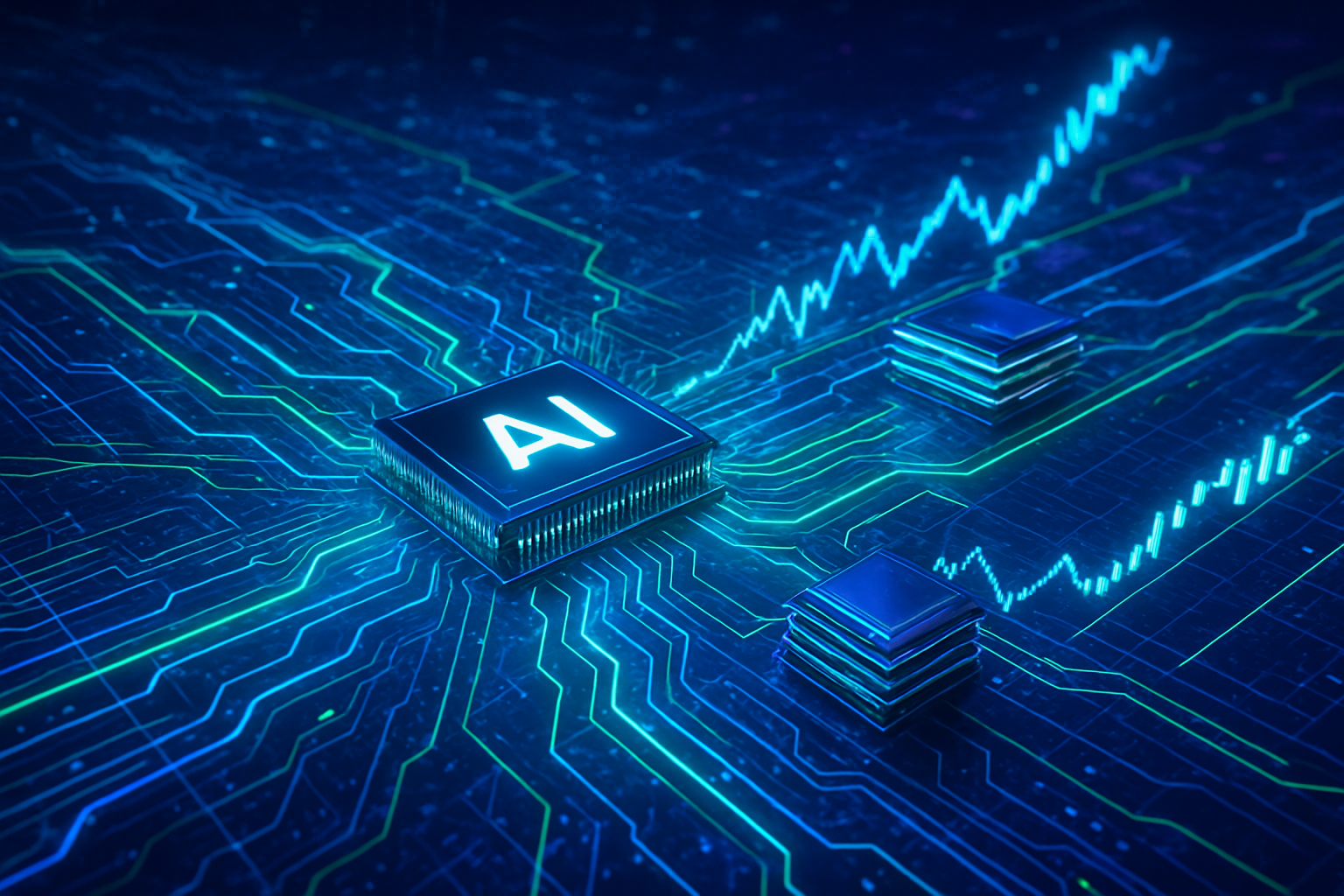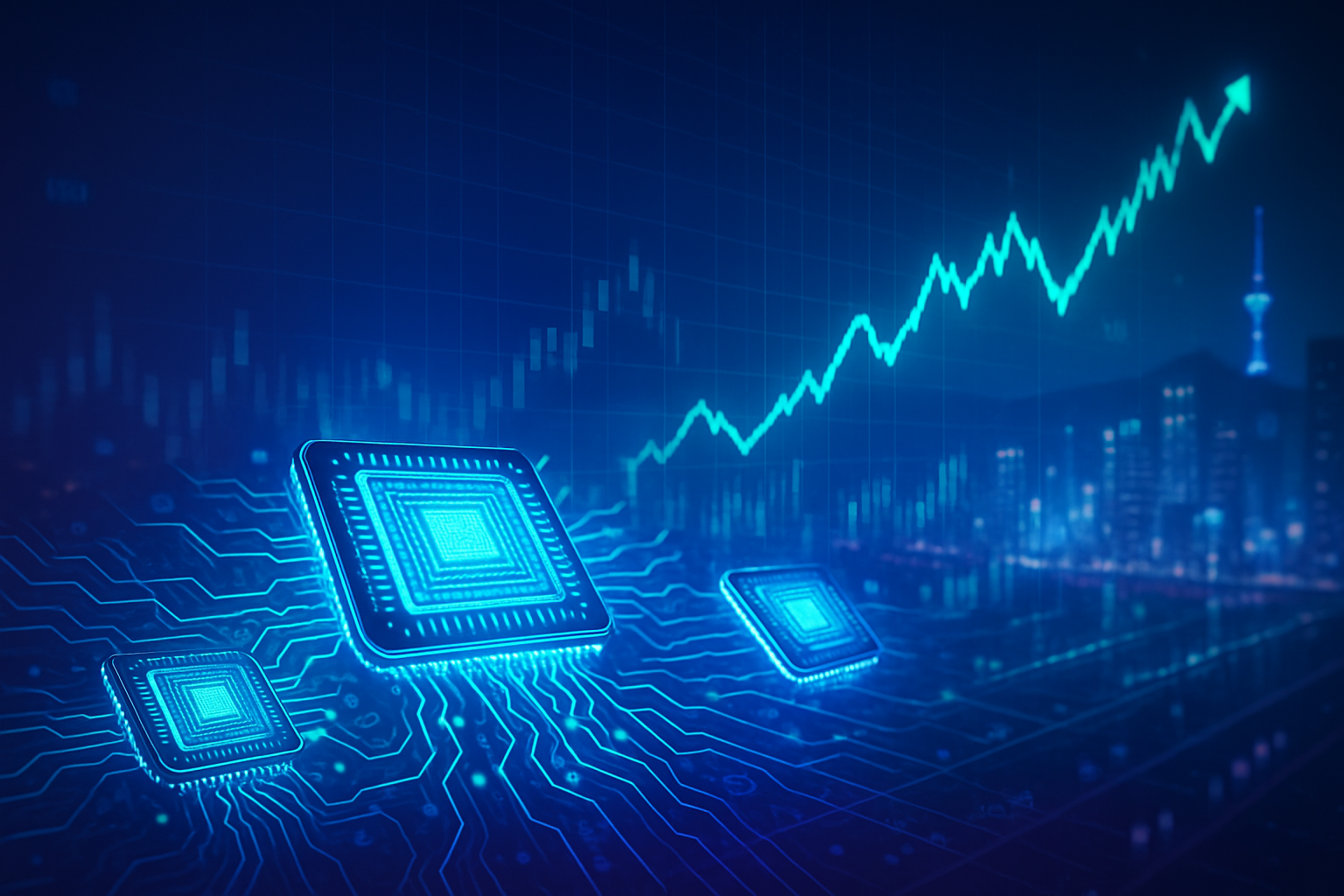Seoul, South Korea – October 13, 2025 – The Korea Composite Stock Price Index (KOSPI) has recently achieved historic milestones, surging past the 3,600-point mark and setting multiple all-time highs. This remarkable rally, which has seen the index climb over 50% year-to-date, is overwhelmingly propelled by an insatiable global demand for artificial intelligence (AI) and the subsequent supercycle in the semiconductor industry. South Korea, a global powerhouse in chip manufacturing, finds itself at the epicenter of this AI-fueled economic expansion, with its leading semiconductor firms becoming critical enablers of the burgeoning AI revolution.
The immediate significance of this rally extends beyond mere market performance; it underscores South Korea's pivotal and increasingly indispensable role in the global technology supply chain. As AI capabilities advance at a breakneck pace, the need for sophisticated hardware, particularly high-bandwidth memory (HBM) chips, has skyrocketed. This surge has channeled unprecedented investor confidence into South Korean chipmakers, transforming their market valuations and solidifying the nation's strategic importance in the ongoing technological paradigm shift.
The Technical Backbone of the AI Revolution: HBM and Strategic Alliances
The core technical driver behind the KOSPI's stratospheric ascent is the escalating demand for advanced semiconductor memory, specifically High-Bandwidth Memory (HBM). These specialized chips are not merely incremental improvements; they represent a fundamental shift in memory architecture designed to meet the extreme data processing requirements of modern AI workloads. Traditional DRAM (Dynamic Random-Access Memory) struggles to keep pace with the immense computational demands of AI models, which often involve processing vast datasets and executing complex neural network operations in parallel. HBM addresses this bottleneck by stacking multiple memory dies vertically, interconnected by through-silicon vias (TSVs), which dramatically increases memory bandwidth and reduces the physical distance data must travel, thereby accelerating data transfer rates significantly.
South Korean giants Samsung Electronics (KRX: 005930) and SK Hynix (KRX: 000660) are at the forefront of HBM production, making them indispensable partners for global AI leaders. On October 2, 2025, the KOSPI breached 3,500 points, fueled by news of OpenAI CEO Sam Altman securing strategic partnerships with both Samsung Electronics and SK Hynix for HBM supply. This was followed by a global tech rally during South Korea's Chuseok holiday (October 3-9, 2025), where U.S. chipmakers like Advanced Micro Devices (NASDAQ: AMD) announced multi-year AI chip supply contracts with OpenAI, and NVIDIA Corporation (NASDAQ: NVDA) confirmed its investment in Elon Musk's AI startup xAI. Upon reopening on October 10, 2025, the KOSPI soared past 3,600 points, with Samsung Electronics and SK Hynix shares reaching new record highs of 94,400 won and 428,000 won, respectively.
This current wave of semiconductor innovation, particularly in HBM, differs markedly from previous memory cycles. While past cycles were often driven by demand for consumer electronics like PCs and smartphones, the current impetus comes from the enterprise and data center segments, specifically AI servers. The technical specifications of HBM3 and upcoming HBM4, with their multi-terabyte-per-second bandwidth capabilities, are far beyond what standard DDR5 memory can offer, making them critical for high-performance AI accelerators like GPUs. Initial reactions from the AI research community and industry experts have been overwhelmingly positive, with many analysts affirming the commencement of an "AI-driven semiconductor supercycle," a long-term growth phase fueled by structural demand rather than transient market fluctuations.
Shifting Tides: How the AI-Driven Semiconductor Boom Reshapes the Global Tech Landscape
The AI-driven semiconductor boom, vividly exemplified by the KOSPI rally, is profoundly reshaping the competitive landscape for AI companies, established tech giants, and burgeoning startups alike. The insatiable demand for high-performance computing necessary to train and deploy advanced AI models, particularly in generative AI, is driving unprecedented capital expenditure and strategic realignments across the industry. This is not merely an economic uptick but a fundamental re-evaluation of market positioning and strategic advantages.
Leading the charge are the South Korean semiconductor powerhouses, Samsung Electronics (KRX: 005930) and SK Hynix (KRX: 000660), whose market capitalizations have soared to record highs. Their dominance in High-Bandwidth Memory (HBM) production makes them critical suppliers to global AI innovators. Beyond South Korea, American giants like NVIDIA Corporation (NASDAQ: NVDA) continue to cement their formidable market leadership, commanding over 80% of the AI infrastructure space with their GPUs and the pervasive CUDA software platform. Advanced Micro Devices (NASDAQ: AMD) has emerged as a strong second player, with its data center products and strategic partnerships, including those with OpenAI, driving substantial growth. Taiwan Semiconductor Manufacturing Company (NYSE: TSM), as the world's largest dedicated semiconductor foundry, also benefits immensely, manufacturing the cutting-edge chips essential for AI and high-performance computing for companies like NVIDIA. Broadcom Inc. (NASDAQ: AVGO) is also leveraging its AI networking and infrastructure software capabilities, reporting significant AI semiconductor revenue growth fueled by custom accelerators for OpenAI and Google's (NASDAQ: GOOGL) TPU program.
The competitive implications are stark, fostering a "winner-takes-all" dynamic where a select few industry leaders capture the lion's share of economic profit. The top 5% of companies, including NVIDIA, TSMC, Broadcom, and ASML Holding N.V. (NASDAQ: ASML), are disproportionately benefiting from this surge. However, this concentration also fuels efforts by major tech companies, particularly cloud hyperscalers like Microsoft Corporation (NASDAQ: MSFT), Alphabet (NASDAQ: GOOGL), Amazon.com Inc. (NASDAQ: AMZN), Meta Platforms Inc. (NASDAQ: META), and Oracle Corporation (NYSE: ORCL), to explore custom chip designs. This strategy aims to reduce dependence on external suppliers and optimize hardware for their specific AI workloads, with these companies projected to triple their collective annual investment in AI infrastructure to $450 billion by 2027. Intel Corporation (NASDAQ: INTC), while facing stiff competition, is aggressively working to regain its leadership through strategic investments in advanced manufacturing processes, such as its 2-nanometer-class semiconductors (18A process).
For startups, the landscape presents a dichotomy of immense opportunity and formidable challenges. While the growing global AI chip market offers niches for specialized AI chip startups, and cloud-based AI design tools democratize access to advanced resources, the capital-intensive nature of semiconductor development remains a significant barrier to entry. Building a cutting-edge fabrication plant can exceed $15 billion, making securing consistent supply chains and protecting intellectual property major hurdles. Nevertheless, opportunities abound for startups focusing on specialized hardware optimized for AI workloads, AI-specific design tools, or energy-efficient edge AI chips. The industry is also witnessing significant disruption through the integration of AI in chip design and manufacturing, with generative AI tools automating chip layout and reducing time-to-market. Furthermore, the emergence of specialized AI chips (ASICs) and advanced 3D chip architectures like TSMC's CoWoS and Intel's Foveros are becoming standard, fundamentally altering how chips are conceived and produced.
The Broader Canvas: AI's Reshaping of Industry and Society
The KOSPI rally, driven by AI and semiconductors, is more than just a market phenomenon; it is a tangible indicator of how deeply AI is embedding itself into the broader technological and societal landscape. This development fits squarely into the overarching trend of AI moving from theoretical research to practical, widespread application, particularly in areas demanding intensive computational power. The current surge in semiconductor demand, specifically for HBM and AI accelerators, signifies a crucial phase where the physical infrastructure for an AI-powered future is being rapidly constructed. It highlights the critical role of hardware in unlocking the full potential of sophisticated AI models, validating the long-held belief that advancements in AI software necessitate proportional leaps in underlying hardware capabilities.
The impacts of this AI-driven infrastructure build-out are far-reaching. Economically, it is creating new value chains, driving unprecedented investment in manufacturing, research, and development. South Korea's economy, heavily reliant on exports, stands to benefit significantly from its semiconductor prowess, potentially cushioning against global economic headwinds. Globally, it accelerates the digital transformation across various industries, from healthcare and finance to automotive and entertainment, as companies gain access to more powerful AI tools. This era is characterized by enhanced efficiency, accelerated innovation cycles, and the creation of entirely new business models predicated on intelligent automation and data analysis.
However, this rapid advancement also brings potential concerns. The immense energy consumption associated with both advanced chip manufacturing and the operation of large-scale AI data centers raises significant environmental questions, pushing the industry towards a greater focus on energy efficiency and sustainable practices. The concentration of economic power and technological expertise within a few dominant players in the semiconductor and AI sectors could also lead to increased market consolidation and potential barriers to entry for smaller innovators, raising antitrust concerns. Furthermore, geopolitical factors, including trade disputes and export controls, continue to cast a shadow, influencing investment decisions and global supply chain stability, particularly in the ongoing tech rivalry between the U.S. and China.
Comparisons to previous AI milestones reveal a distinct characteristic of the current era: the commercialization and industrialization of AI at an unprecedented scale. Unlike earlier AI winters or periods of theoretical breakthroughs, the present moment is marked by concrete, measurable economic impact and a clear pathway to practical applications. This isn't just about a single breakthrough algorithm but about the systematic engineering of an entire ecosystem—from specialized silicon to advanced software platforms—to support a new generation of intelligent systems. This integrated approach, where hardware innovation directly enables software advancement, differentiates the current AI boom from previous, more fragmented periods of development.
The Road Ahead: Navigating AI's Future and Semiconductor Evolution
The current AI-driven KOSPI rally is but a precursor to an even more dynamic future for both artificial intelligence and the semiconductor industry. In the near term (1-5 years), we can anticipate the continued evolution of AI models to become smarter, more efficient, and highly specialized. Generative AI will continue its rapid advancement, leading to enhanced automation across various sectors, streamlining workflows, and freeing human capital for more strategic endeavors. The expansion of Edge AI, where processing moves closer to the data source on devices like smartphones and autonomous vehicles, will reduce latency and enhance privacy, enabling real-time applications. Concurrently, the semiconductor industry will double down on specialized AI chips—including GPUs, TPUs, and ASICs—and embrace advanced packaging technologies like 2.5D and 3D integration to overcome the physical limits of traditional scaling. High-Bandwidth Memory (HBM) will see further customization, and research into neuromorphic computing, which mimics the human brain's energy-efficient processing, will accelerate.
Looking further out, beyond five years, the potential for Artificial General Intelligence (AGI)—AI capable of performing any human intellectual task—remains a significant, albeit debated, long-term goal, with some experts predicting a 50% chance by 2040. Such a breakthrough would usher in transformative societal impacts, accelerating scientific discovery in medicine and climate science, and potentially integrating AI into strategic decision-making at the highest corporate levels. Semiconductor advancements will continue to support these ambitions, with neuromorphic computing maturing into a mainstream technology and the potential integration of quantum computing offering exponential accelerations for certain AI algorithms. Optical communication through silicon photonics will address growing computational demands, and the industry will continue its relentless pursuit of miniaturization and heterogeneous integration for ever more powerful and energy-efficient chips.
The synergistic advancements in AI and semiconductors will unlock a multitude of transformative applications. In healthcare, AI will personalize medicine, assist in earlier disease diagnosis, and optimize patient outcomes. Autonomous vehicles will become commonplace, relying on sophisticated AI chips for real-time decision-making. Manufacturing will see AI-powered robots performing complex assembly tasks, while finance will benefit from enhanced fraud detection and personalized customer interactions. AI will accelerate scientific progress, enable carbon-neutral enterprises through optimization, and revolutionize content creation across creative industries. Edge devices and IoT will gain "always-on" AI capabilities with minimal power drain.
However, this promising future is not without its formidable challenges. Technically, the industry grapples with the immense power consumption and heat dissipation of AI workloads, persistent memory bandwidth bottlenecks, and the sheer complexity and cost of manufacturing advanced chips at atomic levels. The scarcity of high-quality training data and the difficulty of integrating new AI systems with legacy infrastructure also pose significant hurdles. Ethically and societally, concerns about AI bias, transparency, potential job displacement, and data privacy remain paramount, necessitating robust ethical frameworks and significant investment in workforce reskilling. Economically and geopolitically, supply chain vulnerabilities, intensified global competition, and the high investment costs of AI and semiconductor R&D present ongoing risks.
Experts overwhelmingly predict a continued "AI Supercycle," where AI advancements drive demand for more powerful hardware, creating a continuous feedback loop of innovation and growth. The global semiconductor market is expected to grow by 15% in 2025, largely due to AI's influence, particularly in high-end logic process chips and HBM. Companies like NVIDIA, AMD, TSMC, Samsung, Intel, Google, Microsoft, and Amazon Web Services (AWS) are at the forefront, aggressively pushing innovation in specialized AI hardware and advanced manufacturing. The economic impact is projected to be immense, with AI potentially adding $4.4 trillion to the global economy annually. The KOSPI rally is a powerful testament to the dawn of a new era, one where intelligence, enabled by cutting-edge silicon, reshapes the very fabric of our world.
Comprehensive Wrap-up: A New Era of Intelligence and Industry
The KOSPI's historic rally, fueled by the relentless advance of artificial intelligence and the indispensable semiconductor industry, marks a pivotal moment in technological and economic history. The key takeaway is clear: AI is no longer a niche technology but a foundational force, driving a profound transformation across global markets and industries. South Korea's semiconductor giants, Samsung Electronics (KRX: 005930) and SK Hynix (KRX: 000660), stand as vivid examples of how critical hardware innovation, particularly in High-Bandwidth Memory (HBM), is enabling the next generation of AI capabilities. This era is characterized by an accelerating feedback loop where software advancements demand more powerful and specialized hardware, which in turn unlocks even more sophisticated AI applications.
This development's significance in AI history cannot be overstated. Unlike previous periods of AI enthusiasm, the current boom is backed by concrete, measurable economic impact and a clear pathway to widespread commercialization. It signifies the industrialization of AI, moving beyond theoretical research to become a core driver of economic growth and competitive advantage. The focus on specialized silicon, advanced packaging, and strategic global partnerships underscores a mature ecosystem dedicated to building the physical infrastructure for an AI-powered world. This integrated approach—where hardware and software co-evolve—is a defining characteristic, setting this AI milestone apart from its predecessors.
Looking ahead, the long-term impact will be nothing short of revolutionary. AI is poised to redefine industries, create new economic paradigms, and fundamentally alter how we live and work. From personalized medicine and autonomous systems to advanced scientific discovery and enhanced human creativity, the potential applications are vast. However, the journey will require careful navigation of significant challenges, including ethical considerations, societal impacts like job displacement, and the immense technical hurdles of power consumption and manufacturing complexity. The geopolitical landscape, too, will continue to shape the trajectory of AI and semiconductor development, with nations vying for technological leadership and supply chain resilience.
What to watch for in the coming weeks and months includes continued corporate earnings reports, particularly from key semiconductor players, which will provide further insights into the sustainability of the "AI Supercycle." Announcements regarding new AI chip designs, advanced packaging breakthroughs, and strategic alliances between AI developers and hardware manufacturers will be crucial indicators. Investors and policymakers alike will be closely monitoring global trade dynamics, regulatory developments concerning AI ethics, and efforts to address the environmental footprint of this rapidly expanding technological frontier. The KOSPI rally is a powerful testament to the dawn of a new era, one where intelligence, enabled by cutting-edge silicon, reshapes the very fabric of our world.
This content is intended for informational purposes only and represents analysis of current AI developments.
TokenRing AI delivers enterprise-grade solutions for multi-agent AI workflow orchestration, AI-powered development tools, and seamless remote collaboration platforms.
For more information, visit https://www.tokenring.ai/.


